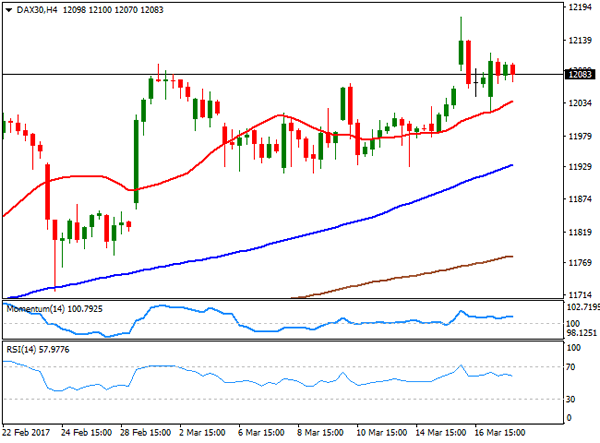EUR/USD
The EUR/USD pair retreated on Friday from a fresh 1-month high of 1.0782, but settled well above the 1.0700 threshold, as broad dollar’s weakness dominated the FX board, following Fed’s monetary policy meeting. The US Central Bank hiked rates as largely anticipated, but retain the stance of a slow pace for upcoming hikes, being far more conservative than expected. At the same time, other major Central Banks’ policymakers, hinted the possibility of retrieving their facilities, further fueling dollar’s easing. The BOE’s meeting showed one MPC member voted to hike rates, whilst ECB’s Nowotny said that the Government Council talked about the possibility of rising rates.
Over the weekend, the G-20 meeting ended with world leaders dropping a decade-long pledge to reject protectionism, unable to find common ground with the new US administration, replacing it with a light commitment to work on strengthening "the contribution of trade to our economies." This outcome will likely weigh on the USD, as it indicates Trump’s desire for a weaker greenback. The week will likely start in slow motion, as the calendar is quite light in Europe and the US, until Wednesday.
After rallying for three weeks in-a-row, the daily chart for the EUR/USD shows that the pair settled above its 20 and 100 DMAs, both around 1.0610, but still below a 200 DMA, at 1.0856. It also shows that technical indicators have lost upward strength and began retreating from near overbought territory, but are far from suggesting a downward move, whilst the price stands above the 38.2% retracement of the post-US election slide at 1.0710. In the shorter term and according to the 4 hours chart, technical indicators are also retreating from overbought readings, but holding well above their mid-lines and with limited bearish strength, whilst the 20 SMA maintains a strong upward slope, converging with the mentioned Fibonacci support. Overall, the bullish potential eased, but there are no signs the pair has topped, and an extension beyond the mentioned high will likely result in further gains for the pair.
Support levels: 1.0710 1.0660 1.0635
Resistance levels: 1.0755 1.0790 1.0820
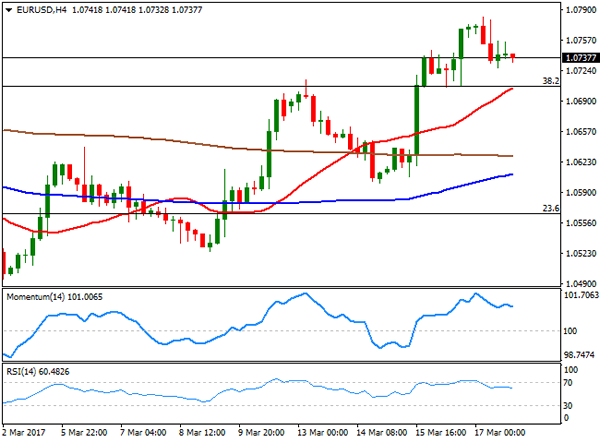
USD/JPY
The USD/JPY pair plunged on Friday to settle at 112.68, its lowest in two weeks, as early week dollar’s weakness was exacerbated by poor US data. On Friday, the preliminary University of Michigan consumer confidence index rose to 97.6 for March from 96.3 in February, beating consensus, but within the report, the 1-year inflation expectations declined to 2.4% from previous 2.7% while the 5-year inflation expectations figure declined to 2.2% from 2.5%, the lowest reading in the survey’s history, and further fueling the idea that the Fed will take its time to raise rates further. A decline in US-Treasury yields also dented the pair, with the 10-year note shedding around 0.10% weekly basis, to end it at 2.50%. The pair is poised to extend its decline from a technical point of view, given that in the daily chart, it settled below its 100 SMA, now losing upward strength a few pips below 140.50, a major Fibonacci resistance, whilst technical indicators head sharply lower within bearish territory. In the 4 hours chart, the pair accelerated its decline after meeting continued selling interest on attempts to surpass a horizontal 200 SMA at 113.50, whilst technical indicators have moderated their bearish momentum, but consolidate within oversold readings, indicating further slides are likely towards 112.00.
Support levels: 112.50 112.10 111.65
Resistance levels: 113.05 113.50 114.00
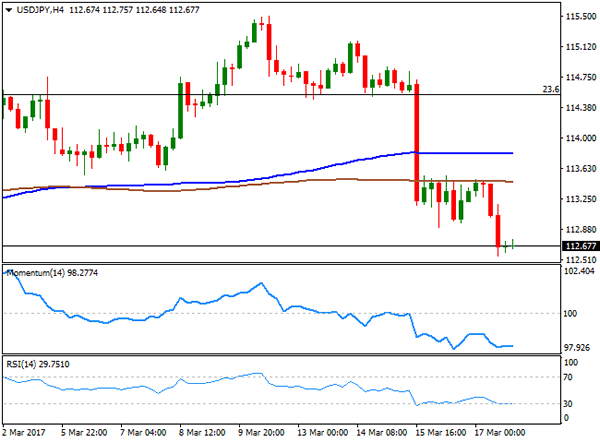
GBP/USD
The GBP/USD pair settled at its highest in two-weeks, a couple of pips shy of the 1.2400 figure, as the Pound got a nice boost from the latest BOE’s meeting that took place last Thursday. The Central Bank left its economic policy unchanged, but among the MPC there was one dissenter, Christine Forbes, who voted for a rate hike. But what actually fueled the GBP was a sentence included in the statement that reads "some members noted that it would take relatively little further upside news on the prospects of activity or inflation for them to consider that a more immediate reduction in policy support might be warranted." The UK will release multiple inflation figures this Wednesday, including PPI, CPI and Retail Price index, and if the figures beat market’s expectations, will likely fuel Pound’s rally, as a rate hike in the UK will become more imminent. From a technical point of view, the daily chart shows that technical indicators have entered positive territory, maintaining their bullish slopes and at their highest since late February, whilst the price is well above a now flat 20 SMA, around 1.2290, all of which supports additional gains for the upcoming days. In the 4 hours chart, technical indicators have lost upward strength but hold within overbought territory, whilst the 20 SMA present a sharp bullish slope, also standing in the 1.2290 region. In this last time frame, the price has settled above its 200 EMA for the first time this March, adding to the bullish case. The immediate resistance is now 1.2425, the 38.2% retracement of the January rally, while a critical support comes at 1.2345, the 50% retracement of the same rally and February’s low.
Support levels: 1.2345 1.2300 1.2260
Resistance levels: 1.2425 1.2470 1.2510
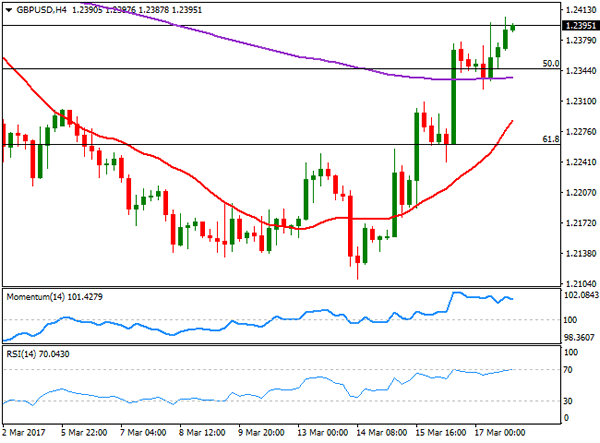
GOLD
After a 2-week decline, gold prices recovered this past one, with spot settling at $1,229.05 a troy ounce, up 2.4% for the week, underpinned by Fed’s decision to maintain its rate-hike pace unchanged, which weakened the greenback against all of its major rivals. The bright metal consolidated on Friday, holding within the upper end of Thursday’s range, but unable to breach the weekly high of 1,233.62, somehow indicating fading buying interest. In the daily chart, the commodity closed the day around a horizontal 20 DMA and slightly below a major Fibonacci resistance at 1,230.10, whilst technical indicators have lost upward strength, although the RSI stands at 54, this last limiting the bearish potential. In the 4 hours chart, the 20 SMA maintains a strong bullish slope below the current level, whilst technical indicators hold within overbought territory with no signs of turning lower, in line with the longer term perspective.
Support levels: 1,223.15 1,212,90 1,203.30
Resistance levels: 1,230.10 1,242.50 1,250.65
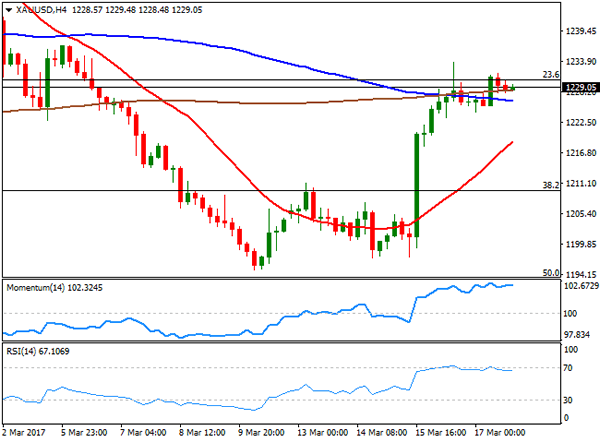
WTI CRUDE
Crude oil prices posted a modest gain this last week after reaching fresh 2017 lows, with West Texas Intermediate futures ending at $48.69 a barrel after trading as low as 47.08. The commodity pared losses after the US weekly EIA report posted a surprise drawdown after 9 straight weeks of advances, although the recovery was contained by continued fears of further gains in US production, after Friday’s Baker Hughes report. According to the oilfield company, the number of active US rigs drilling for oil rose by 14 to 631, the ninth consecutive weekly gain and the highest number of active drills since September 2015. The daily chart shows that WTI developed below the 200 DMA all the week, failing to surpass it, whilst the 20 DMA heads sharply lower above the current level, after crossing below the 100 DMA. Furthermore, technical indicators in the mentioned time frame have turned flat within oversold territory after correcting extreme readings, all of which maintains the risk towards the downside. In the 4 hours chart, the price is stuck around a modestly bullish 20 SMA, whilst technical indicators head nowhere within neutral territory. A downward extension below 48.00 will likely result in a deeper slide beyond the mentioned weekly high, and leaving doors open for a test of the 45 threshold.
Support levels: 48.00 47.30 46.65
Resistance levels: 49.10 49.75 50.50
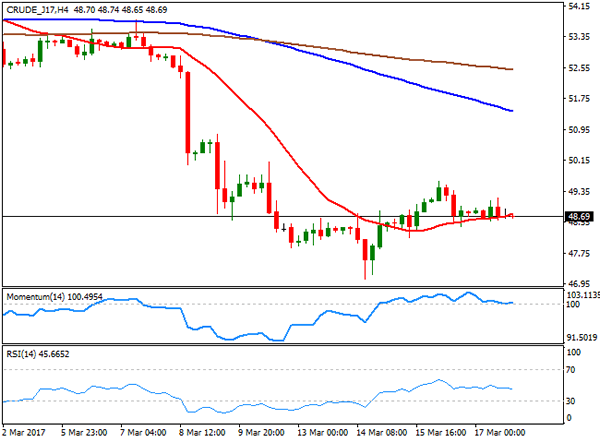
DJIA
Wall Street closed mixed once again last Friday, with major indexes not far from their daily opening levels. The Dow Jones Industrial Average lost 20 points and settled at 20,914.62, while the S&P shed 3 points, to close at 2,378.25. The Nasdaq Composite closed flat at 5,901.00. The Dow momentum faded as investors struggle to digest monetary and political news, following Fed’s decision and Donald Trump’s fiscal 2018 budget proposal, which put forth massive cuts throughout the federal government. Financial and health care stocks led the decline, and within the Dow, Goldman Sachs was the worst performer, down by 1.72%, followed by JP Morgan that shed 1.05% and UnitedHealth Group which lost 0.93%. The best performer was 3M that gained 1.08%. Despite closing the week modestly higher, the Dow daily chart presents an increasing bearish potential, as the index is barely holding above a horizontal 20 DMA, while the RSI indicator retreated further from overbought readings and the RSI indicator entered bearish territory with a strong downward slope. In the 4 hours chart, the index is stuck around its 20 and 100 SMAs, both converging in the current 20,910 level, whilst technical indicators pose a modest bearish potential, turning south around their mid-lines.
Support levels: 20,890 20,852 20,817
Resistance levels: 20,925 20,978 21,015
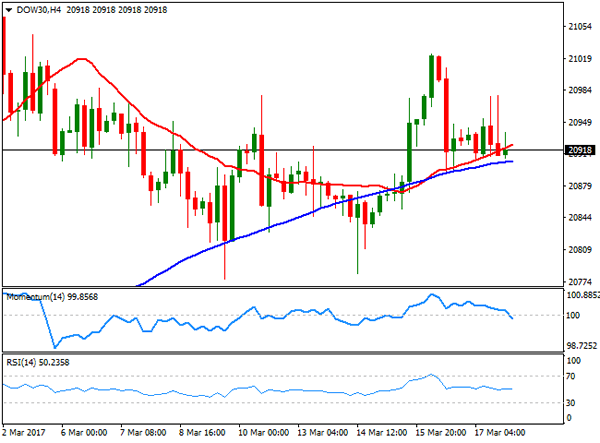
FTSE 100
The FTSE 100 advanced 9 points or 0.12% on Friday, to close the week at 7,424.96, its second consecutive record close and after extending its rally to a new intraday record high of 7,447. The advance was limited by Pound’s strength. Insurance firm Admiral was the best performer, adding 1.94%, followed by ConvaTec Group that gained 1.88%. Royal Bank of Scotland was among the best performers, advancing 1.37%, following upbeat comments from Natixis analysts. Mining-related equities were off the radar as metals consolidated on Friday, while Old Mutual was the worst performer, down 2.38%. The index retains its positive tone in the daily chart, as it continued developing well above moving averages, whilst technical indicators remain within positive territory, although with limited upward momentum. In the 4 hours chart, the upside remains constructive, as the 20 SMA maintains a strong bullish slope below the current level, whilst technical indicators have turned north within positive territory, favoring a new leg higher on a break above the mentioned high.
Support levels: 7,399 7,363 7,338
Resistance levels: 7,447 7,480 7,510
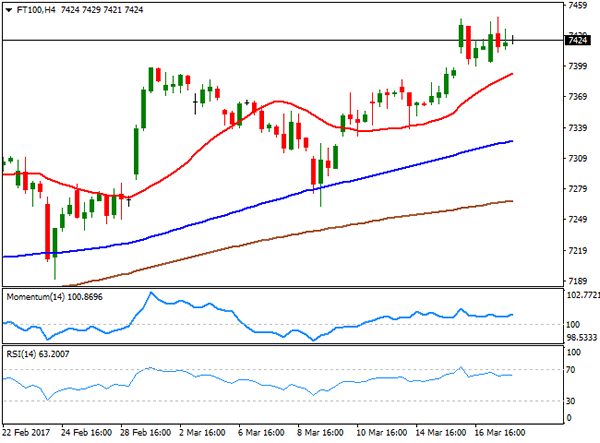
DAX
European equities posted modest gains last Friday, with the German DAX ending the week at 12,095.24, up on the day by 12 points, but the week at its highest since April 2015, with sharp losses in automobile stocks offsetting other sectors’ gains. E.ON was the best performer within the DAX, closing 4.83% higher, followed by Commerzbank that gained 1.54%. Deutsche Bank was the worst performer, down 2.13%, followed by Volkswagen that shed 1.45%. The daily chart shows that the index held above a bullish 20 DMA, currently at 11,973, but that technical indicators have lost their upward momentum, turning flat within positive territory, indicating easing bullish strength, but not enough to suggest an upcoming downward move. In the 4 hours chart, technical indicators have also turned neutral within positive territory, whilst the index holds above all of its moving averages, with the shortest now providing an immediate dynamic support at 12,037.
Support levels: 12,039 11,977 11,932
Resistance levels: 12,105 12,140 12,178
